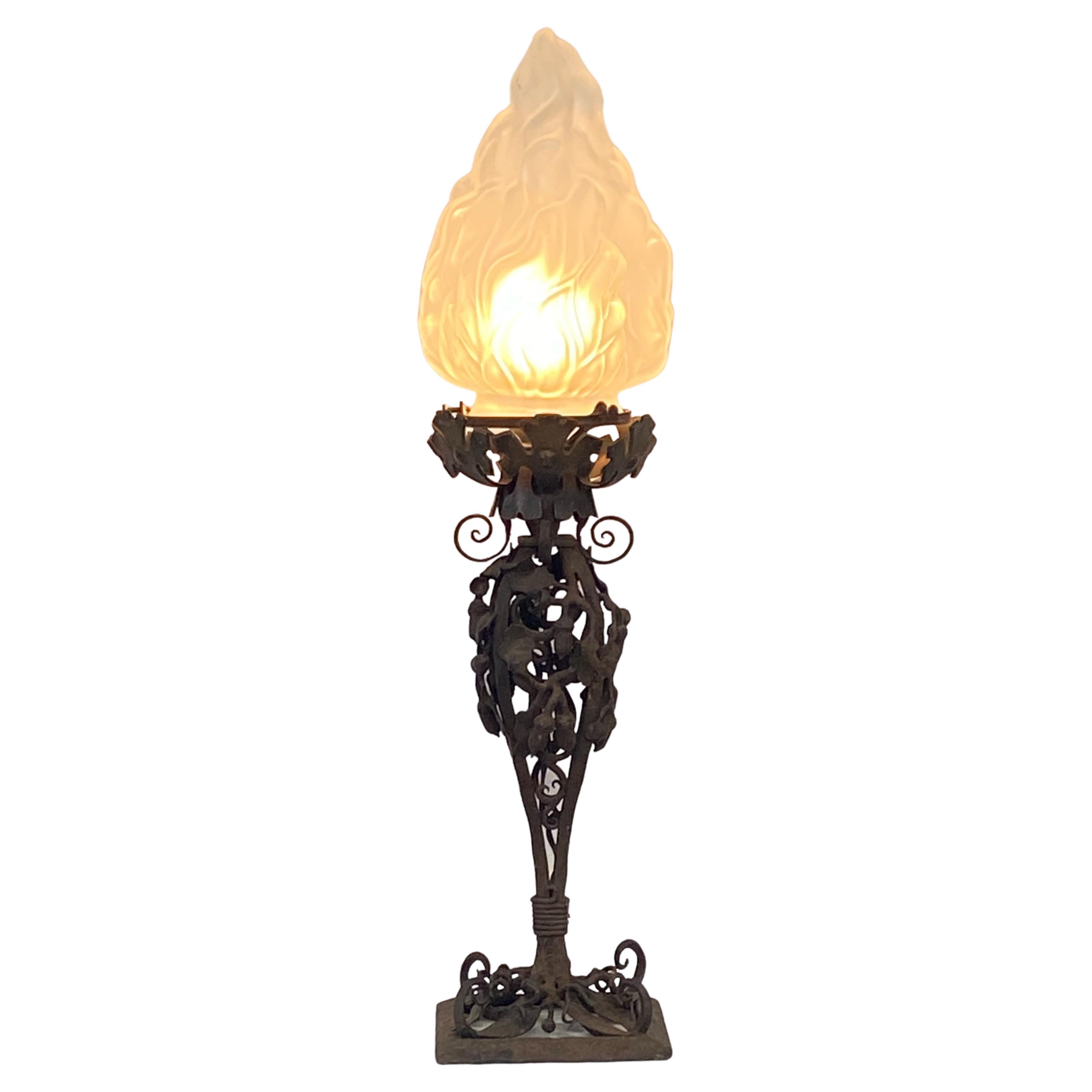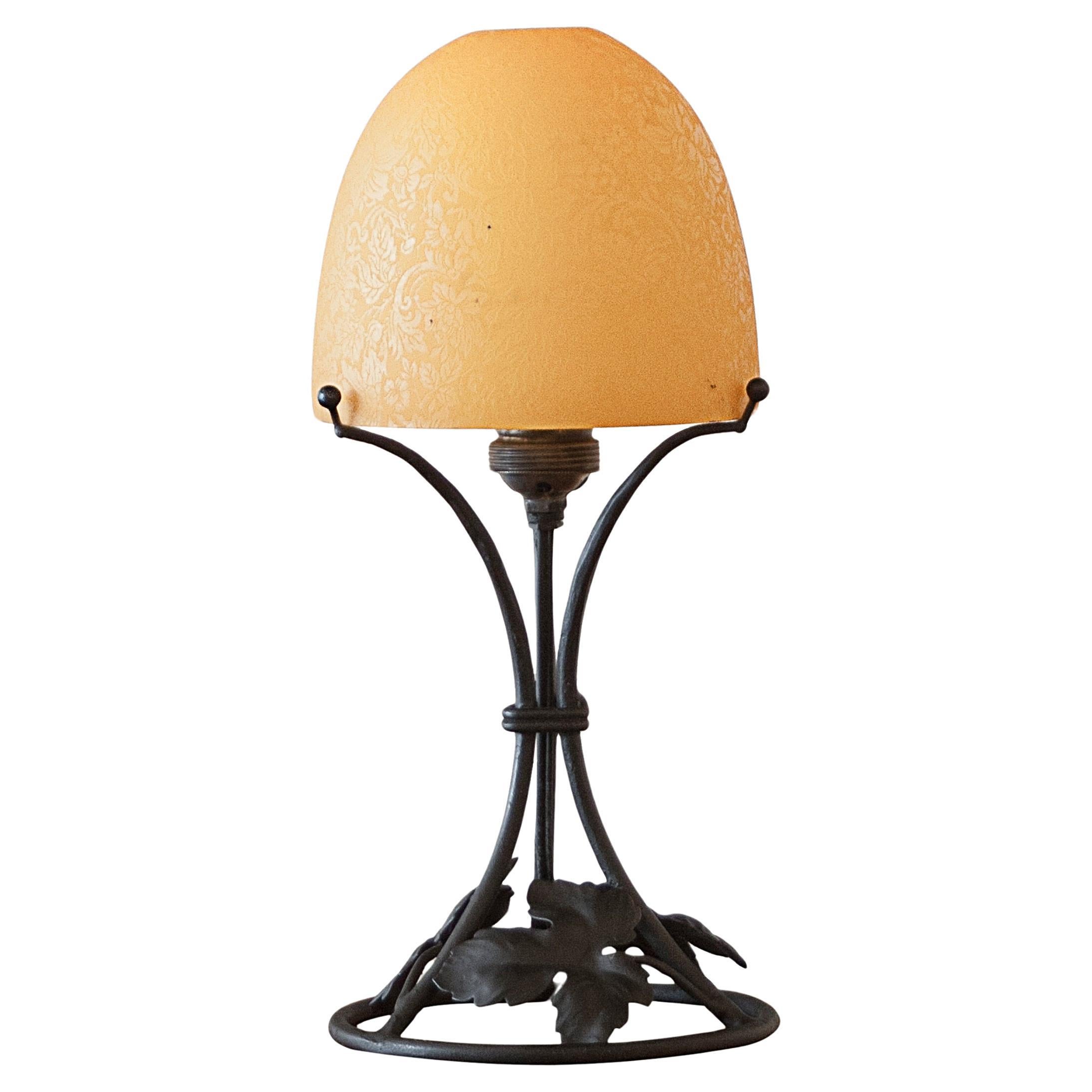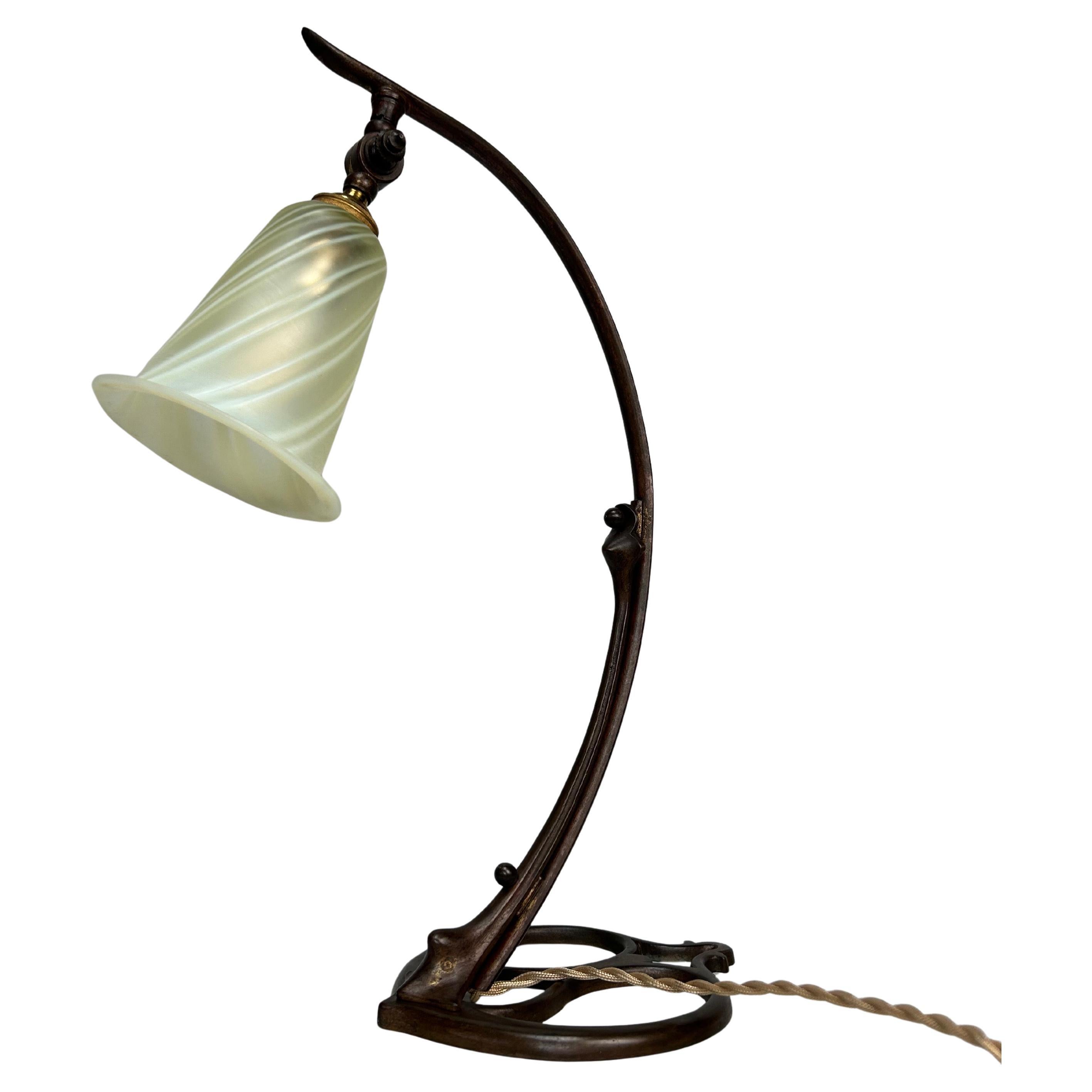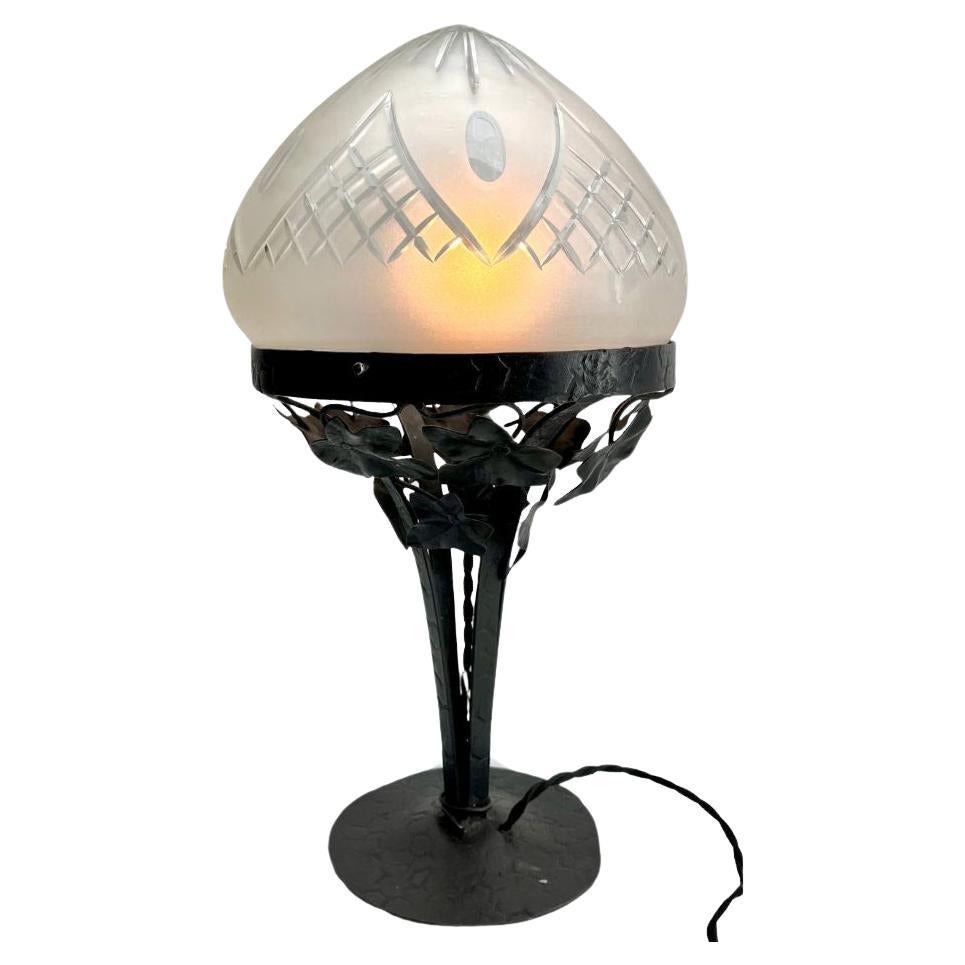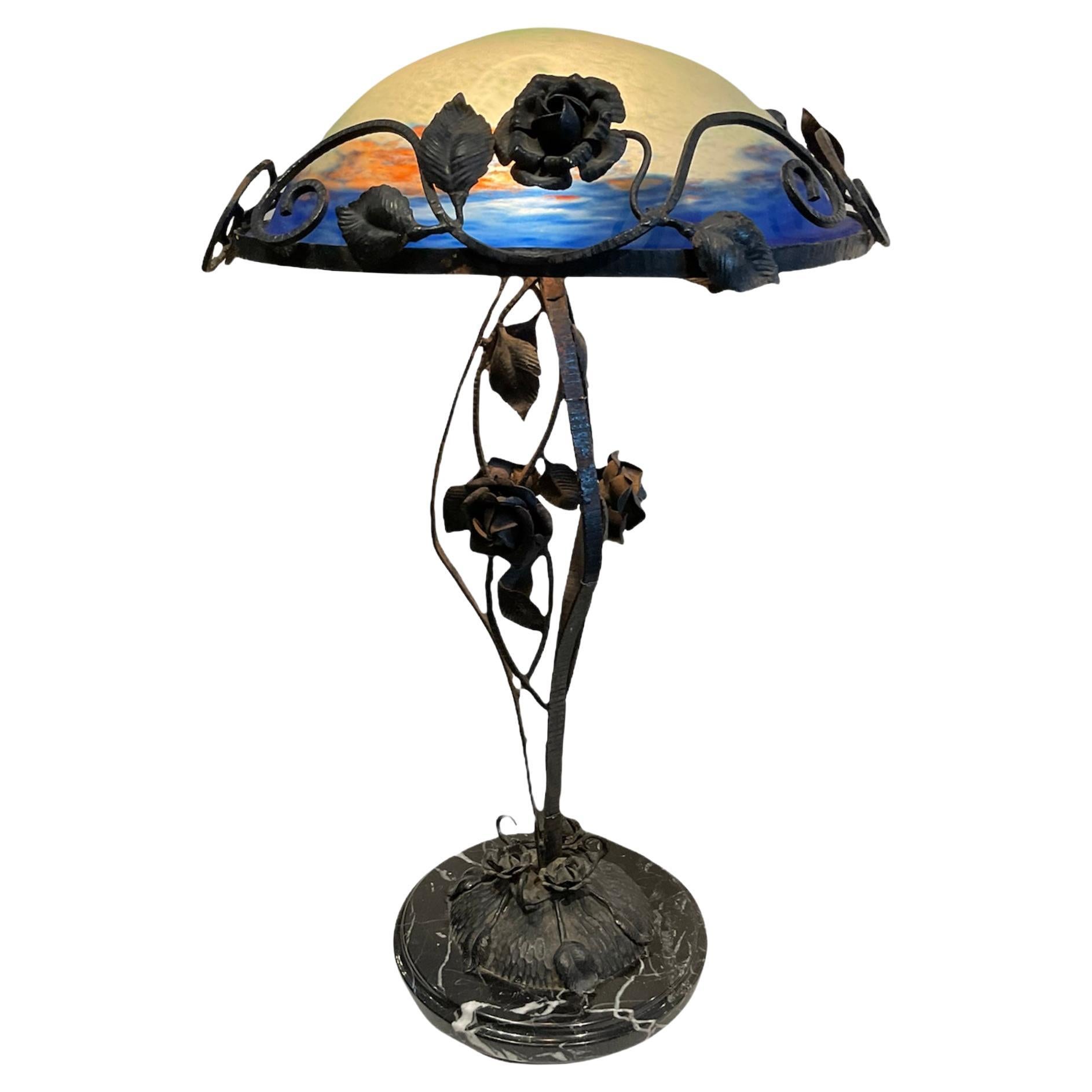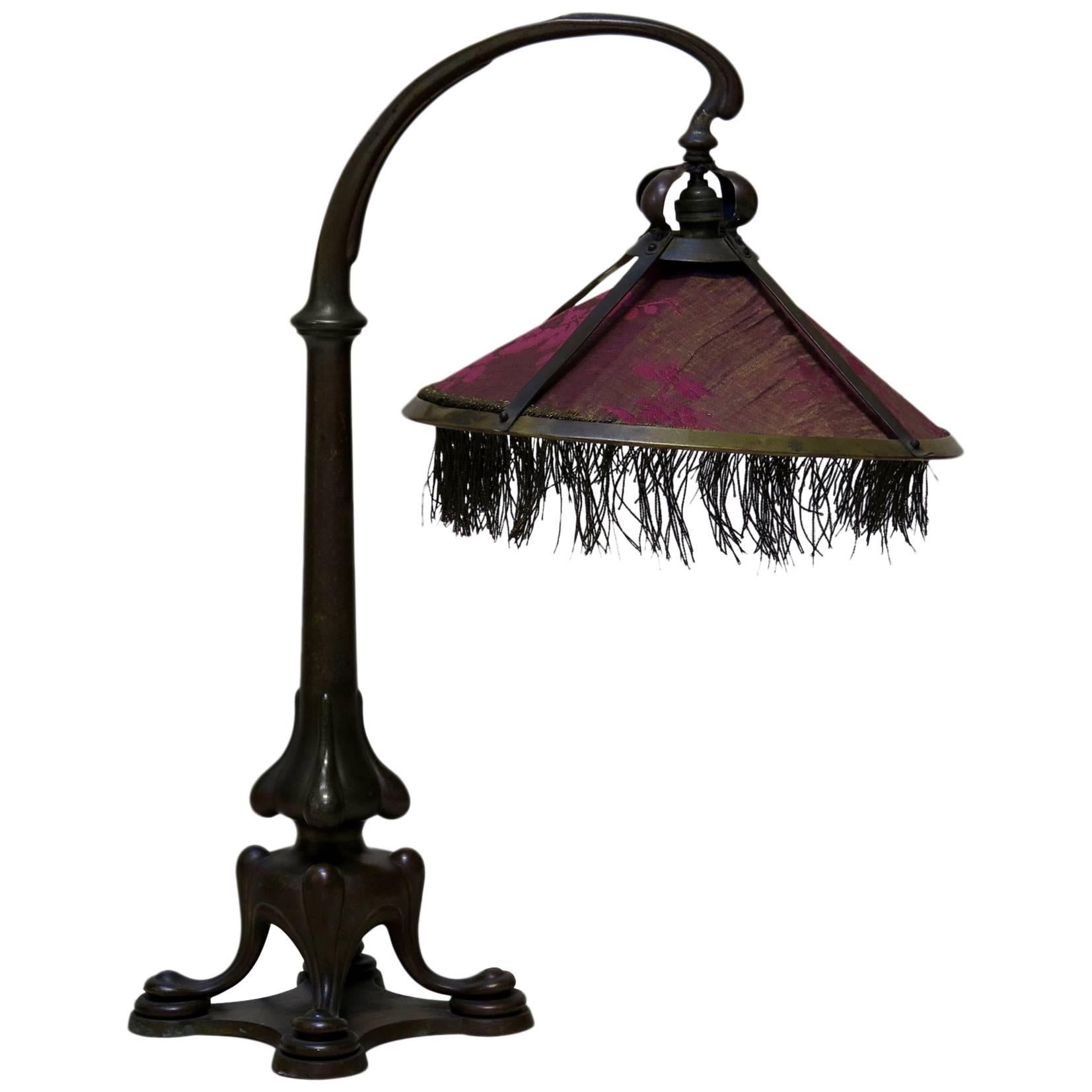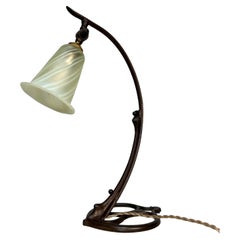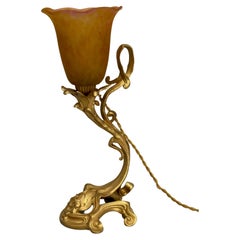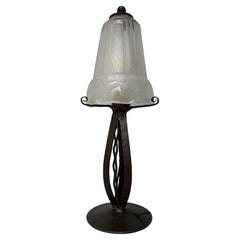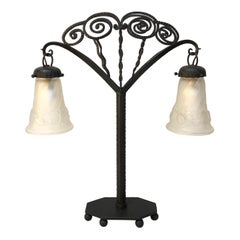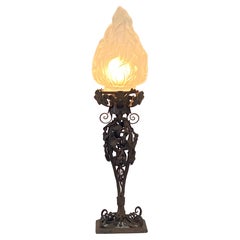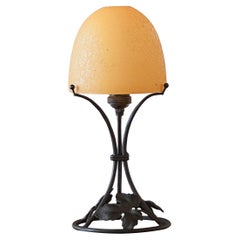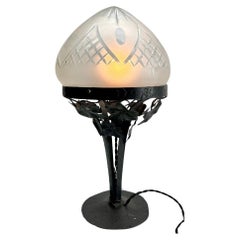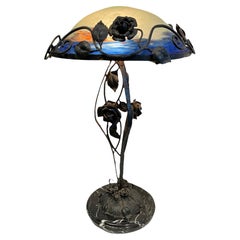Items Similar to Art Nouveau Lamp Stamped Les Etains de France
Video Loading
Want more images or videos?
Request additional images or videos from the seller
1 of 11
Art Nouveau Lamp Stamped Les Etains de France
$1,010.33
£752.38
€850
CA$1,394.90
A$1,546.45
CHF 812.72
MX$18,926.06
NOK 10,150.07
SEK 9,526.86
DKK 6,471.62
About the Item
Flower lamp circa 1900.
Pewter base topped with an opalescent uraline tulip.
Electrified and in perfect condition.
Stamped Les Etains De France.
Total height: 35 cm
Pedestal diameter: 18 cm
Weight: 1.4 Kg
- Dimensions:Height: 13.78 in (35 cm)Diameter: 7.09 in (18 cm)
- Power Source:Hardwired
- Voltage:110-150v,220-240v
- Lampshade:Included
- Style:Art Nouveau (Of the Period)
- Materials and Techniques:
- Place of Origin:
- Period:
- Date of Manufacture:1900
- Condition:
- Seller Location:NANTES, FR
- Reference Number:1stDibs: LU7403243762882
About the Seller
No Reviews Yet
Vetted Professional Seller
Every seller passes strict standards for authenticity and reliability
1stDibs seller since 2022
50 sales on 1stDibs
Typical response time: 3 hours
- ShippingRetrieving quote...Shipping from: NANTES, France
- Return Policy
Authenticity Guarantee
In the unlikely event there’s an issue with an item’s authenticity, contact us within 1 year for a full refund. DetailsMoney-Back Guarantee
If your item is not as described, is damaged in transit, or does not arrive, contact us within 7 days for a full refund. Details24-Hour Cancellation
You have a 24-hour grace period in which to reconsider your purchase, with no questions asked.Vetted Professional Sellers
Our world-class sellers must adhere to strict standards for service and quality, maintaining the integrity of our listings.Price-Match Guarantee
If you find that a seller listed the same item for a lower price elsewhere, we’ll match it.Trusted Global Delivery
Our best-in-class carrier network provides specialized shipping options worldwide, including custom delivery.More From This Seller
View AllArt Nouveau Lamp Base Model Hearts
Located in NANTES, FR
Art nouveau lamp circa 1910.
Bronze and brown patinated brass base, heart model.
Uraline tulip in opalescent glass.
The lamp is fully electrified and in ...
Category
Vintage 1910s French Art Nouveau Table Lamps
Materials
Brass, Bronze
Art Nouveau Lamp by Victor Saglier and Daum Nancy
By Daum, Victor Saglier
Located in NANTES, FR
Gilt bronze lamp around 1900, probably by Majorelle executed by Victor Saglier. Stamped on the foot VS.
Glass paste tulip signed Daum Nancy.
Lamp electrified and in perfect condition.
Total height: 38.5 cm - 15.15 in
width: 15cm
depth: 13cm
weight: 2.3kg
Victor Saglier (1809 - 1894)
Victor Saglier is a ceramist and goldsmith known in particular for his creations in the Art Nouveau style of the late 19th century.
He produces, among other things, objects in enamelled glass, gilded metal and numerous pieces of silverware.
On his death, the company was bought by his brothers who continued production until 1948.
Victor Saglier's objects are signed by the "VS" brand.
Known for his Art Nouveau work, Saglier made several pieces for Louis Majorelle, Daum and Émile Gallé. Its style is typically French Art Nouveau in the language of the École de Nancy. He often drew inspiration from nature for his work, the logic of which helped design both forms and settings. The sign of master goldsmith Victor Saglier is an oval-shaped three-master sailboat surrounded by the letters V and S in a rectangle.
Saglier made everyday objects such as glass vases, bowls and pitchers with metal mounts, planters, tea and coffee services and candlesticks in bronze or silver-yellow metal or cast zinc.
On his death, the Victor Saglier company at 12 rue d'Enghien in Paris became Saglier Frères. It was run by his brothers Eugène and André until his death in 1948.
Daum (French establishment created in 1878) is a glass and crystal workshop located in Nancy. Founded by the industrialist and notary Jean Daum, the workshop was then taken over by his sons Auguste and Antonin, who ran it during the Art Nouveau period.
It was not until the Universal Exhibition of 1900 that the company was at the forefront of the decorative art scene, when Daum received the prestigious Grand Prix medal. At this time, Daum glass became more complex, acid treatment was often used in the cutting, enameling and etching of a piece to produce glass masterpieces. Daum also produces applied glass elements, such as handles and ornamental motifs in naturalistic shapes. The Daum brothers quickly became big names in Art Nouveau, rivaling the famous designer Émile Gallé, and established themselves as leaders in the field of decorative glass after his death.
In 1906, Daum revived glass paste, a process by which glass is transformed into paste, then it is applied to the surface of a mold and fired. This technique originates from ancient Egypt. Today, Daum is the only industrial crystal manufacturer that uses the glass paste process for its glass objects and crystal sculptures.
Following the First World War, Paul Daum began to develop works in the Art Deco style, moving away from naturalistic forms and turning to linear, angular, simplified forms and geometric patterns characteristic of the movement. After the Second World War, Henri and Michel Daum became interested in the transparency of glass and pure lines. Daum collaborates with a large number of famous artists, such as Louis Majorelle, Salvador Dalí, Hilton Mac Connico, Elizabeth Garouste and Mattia Bonetti to create glass paste objects.
Category
20th Century French Art Nouveau Table Lamps
Materials
Bronze
Art Deco Lamp Signed Maynadier
Located in NANTES, FR
Art Deco lamp circa 1930.
Wrought iron base and pressed molded tulip with floral decoration.
In perfect condition and electrified.
Total height: 34 cm
Base diameter: 10.5 cm
Weight:...
Category
Mid-20th Century French Art Deco Table Lamps
Materials
Wrought Iron
Art Deco Lamp 2 Tulips Attributed to Genêt & Michon
By Genet & Michon
Located in NANTES, FR
Art Deco Lamp 2 Tulips Attributed to Genêt & Michon
Art deco lamp with two tulips around 1930.
Wrought iron frame decorated with windings.
The tulips are made of molded glass decora...
Category
Mid-20th Century French Art Deco Table Lamps
Materials
Wrought Iron
Quezal Art Nouveau Lamp
By Quezal
Located in NANTES, FR
Art nouveau lamp circa 1910.
Brass and copper base.
Iridescent glass tulip signed Quezal.
In perfect condition and electrified.
Total height: 38.5 cm
Base diameter: 15.5 cm
Width: 30 cm
Quezal Art Glass
Quezal Art Glass – The Journal of Antiques and Collectibles – April 2003
By Malcolm Mac Neil
Some of the most beautiful and alluring art glass made in America during the early part of the 20th Century was made by the Quezal Art Glass and Decorating Company. Often in the shape of blossoming lilies with brilliant gold interiors and colorfully decorated with floral and other motifs inspired by nature, Quezal art glass ranks right alongside the iridescent glass of Louis Comfort Tiffany and Frederick Carder. Quezal artisans created an extensive range of decorative and useful items, including vases, compotes, finger bowls, open salts, candle holders, and shades for lighting fixtures, which are equivalent in terms of beauty and quality of craftsmanship to Tiffany’s Favrile and Carder’s Aurene glass. In recent years, glass collectors have discovered anew the special charms and appeal of Quezal art glass, and collector desirability for this lovely glassware has increased dramatically.
The Quezal Art Glass and Decorating Company was incorporated a century ago, on March 27, 1902. It was founded by Martin Bach, Sr., Thomas Johnson, Nicholas Bach, Lena Scholtz, and Adolph Demuth. The factory was located on the corner of Fresh Pond Road and Metropolitan Avenue in Maspeth, Queens, New York. In October 1902, the trademark “Quezal” was successfully registered. By 1904, roughly fifty glassworkers were employed at the works.
Martin Bach, Sr. was the president, proprietor, and guiding force behind this successful company. Born in 1862 in Alsace-Lorraine to German parents, he emigrated to the United States in 1891. Before his emigration, Bach worked in Saint-Louis, France, at the Saint-Louis Glass Factory. After Bach arrived in this country, he was hired by Louis C. Tiffany as the latter’s first batch-mixer or chemist at the newly established Tiffany Glass and Decorating Company, in Corona, Queens. After a period of about eight years, Bach left Tiffany and established his own glassworks. By this time, Bach had already started his small family. He and his German-born wife, Anne-Marie Geisser, whom he married in the fall of 1889, in Paris, France, had three children. Two daughters, Jennie and Louise, were born in France and a son, Martin, Jr., was born in Corona.
Bach was assisted by Thomas Johnson, an English immigrant, and Maurice Kelly, a native of Corona, both of whom were gaffers or master glassblowers. Johnson and Kelly helped pave the way for Quezal’s early accomplishments and later recognition. Thomas Johnson, like Bach, was a founding member and also previously employed by Louis C. Tiffany. Johnson’s association with Quezal, however, was relatively short lived. Around 1907, Johnson left for Somerville, Massachusetts, where he became involved in making Kew Blas glass, under William S. Blake at the Union Glass Company. Maurice Kelly’s tenure with Quezal was also brief. Kelly worked at Quezal from January 1902 until July 1904, but by November 1904, he was making Favrile glass at Tiffany Furnaces, where he would happily remain until 1918.
To this day, the belief still exists that there once existed a man named Quezal, who worked for Louis C. Tiffany, and it is after him that Quezal glass is named. In truth, however, the founders of the Quezal Art Glass and Decorating Company named the company and its products after one of the world’s most beautiful birds, the elusive and rare quetzal, which dwells in the treetops of the remote tropical forests of Central America. A rare company promotional brochure provides a vivid description of the quetzal: Of all the birds of the America’s, it is the most gorgeous. No more splendid sight is to be seen in all the world than a quezal, flying like a darting flame through the depths of a Central American forest. Its back is of a brilliant metallic green, so vivid it shines even in the twilight of the woods like a great emerald and its breast is a crimson so deep and bright that every motion of the wonderful creature is a flashing of rubies among the trees and giant creepers. It bears a true golden crown upon its head – a helmet of bright yellow and green, shaped just as the helmet of old Aztec kings were shaped. Its tail is composed of lacelike plumes, extending more than two and one-half feet beyond its body.
The quezal was certainly an appropriate designation for the company’s resplendent glassware. One of the most prized characteristics of Quezal art glass is the shimmering and dazzling brilliance reflected in the iridescent surfaces on the interior as well as exterior of the glass. The radiant rainbow colors in metallic hues, including gold, purple, blue, green, and pink, to name only a few, were certainly inspired by the quetzal and its feathers. Not surprisingly, lustrous feathers, in shades of opal, gold, emerald, and blue, are among the most common decorative motifs encountered on Quezal glass.
The enduring hallmark of Quezal art glass is its unique expression of the Art Nouveau style, based on organic shapes and naturalistic motifs coupled with technical perfection in the execution. Vases, compotes, drinking vessels, and shades for lighting fixtures were often fashioned to resemble flowers such as crocuses, tulips, calla lilies, casablanca lilies, and jack-in-the-pulpits. Variously colored inlaid threads of glass, pulled and twisted by hooks, simulate naturalistic floral and leaf patterns, lily pads, clover leafs, and vines. Opal, gold, and green colors prevail and the glass is generally opaque. Red is the rarest color of all. Compared with Tiffany’s Favrile glass, the crisp, vivid, and colorful decoration of Quezal art glass is distinctively precise, symmetrical, and restrained.
Other Quezal wares recall shapes and styles favored in ancient Egypt, Persia, Greece, and Rome, as well as the Italian Renaissance and the Georgian period in England. This is especially true of classic-shaped vases and bowls of translucent amber glass, which have a single surface color such as iridescent gold or blue. Still, others were inspired by traditional Chinese and Japanese forms.
The Gorham Manufacturing Company in Providence, Rhode Island, and the Alvin Silver Manufacturing Company in Sag Harbor, Long Island, purchased Quezal art glass, which they in turn embellished in their shops with silver overlay decoration in the fashionable Art Nouveau style and later resold. Gorham’s silver overlay designs mostly include stylized floral motifs. Alvin’s silver designs are wonderfully organic. One sumptuous design is of a group of sinuous iris blossoms with carefully articulated petals surrounded by attenuated meandering vines. Collectors should note that not all silver-deposit pieces are marked with a maker’s mark since the silversmith had to be quite careful not to damage the glass underneath.
A rare 1907 retail catalog survives from Bailey, Banks, and Biddle Company, a luxury goods retailer in Philadelphia, which reveals original retail prices of Quezal art glass. A surprising revelation provided by this catalog is that Quezal art glass was nearly twice as expensive as comparable French imported glass made by such renowned firms as Gallé and Daum. Hock glasses, a stemmed glass used primarily for drinking German white wine, were sold by the dozen and retailed between $50 and $75. Fingerbowls were also sold by the dozen and retailed between $50 and $100. These high retail prices were nearly the same as those charged for Tiffany’s Favrile glass, and suggest Quezal art glass was also marketed towards the high-end or luxury market.
Electricity was a brand new invention in the late 1800s and American glass manufacturers developed novel approaches for concealing the electric light bulb, which was rather harsh to the eye and perhaps unflattering to the domestic interior. Tiffany, Steuben, and Quezal responded to this need with the most extraordinary and beautiful art-glass shades, all of which were hand-made and exquisitely fashioned. Many other companies also made art glass shades for table and floor lamps, electroliers, hallway fixtures, and wall sconces, but it was Quezal that excelled in this area and was the most prolific.
Quezal art glass shades were available in an infinite variety of shapes, sizes, colors, and decorations. Some shades are formed and decorated as lilies while others are bell-shaped and have ribbed or textured decoration. Rims are usually plain but sometimes are notched or ruffled. Common motifs include feather or hooked feather, leaf and vine, applied flowers, drape, fishnet, King Tut, and spider webbing. The workmanship shown on most Quezal shades...
Category
Vintage 1910s French Art Nouveau Table Lamps
Materials
Brass, Copper
$3,328
Art Nouveau lamp circa 1910
Located in NANTES, FR
Beautiful Art Nouveau lamp, circa 1910.
Brown-veined alabaster shell.
The base is bronze with floral decoration.
Electric and in perfect condition.
Total Height: 52 cm
Shell Diamete...
Category
Vintage 1910s French Art Nouveau Table Lamps
Materials
Alabaster, Bronze
You May Also Like
Late 19th / Early 20th Century French Art Nouveau Table Lamp
Located in San Francisco, CA
An exceptional wrought iron lamp base. We believe this was probably a custom crafted gas newel post lamp originally. A considerable amount of skilled workmanship went into the iron work with an Art Nouveau design of acorns and oak leaves. The flame glass shade...
Category
Antique Late 19th Century French Art Nouveau Table Lamps
Materials
Wrought Iron
Table Lamp, Style: Jugendstil, Art Nouveau, Liberty, Year: 1900, French
Located in Ciudad Autónoma Buenos Aires, C
To take care of your property and the lives of our customers, the new wiring has been done.
We have specialized in the sale of Art Deco and Art Nouveau and Vintage styles since 1982....
Category
Antique Early 1900s French Art Nouveau Table Lamps
Materials
Iron
Art Nouveau Lamp in Wrought Iron with Glass Shade Style of Val Saint Lambert
By Val Saint Lambert
Located in Verviers, BE
The 1930s, Brlgium
A wonderful Belgium Art Nouveau lamp.
The stands are handmade in wrought iron with black finish patina and hammered with a floral pattern.
The metalwork is of ex...
Category
Vintage 1930s Belgian Art Nouveau Table Lamps
Materials
Wrought Iron
Degue Art Nouveau Style Hand Painted Lamp
By Degué
Located in Guaynabo, PR
This is a hand painted half moon shaped glass paste shade lamp mounted in a wrought iron stem branches of roses and leaves. The half moon shade depicts an orange and royal blue color...
Category
Early 20th Century French Art Nouveau Table Lamps
Materials
Wrought Iron
$2,000 Sale Price
20% Off
Solid Bronze Art Nouveau Table Lamp France, circa 1900
Located in Isle Sur La Sorgue, Vaucluse
Elegant and heavy desk lamp made out of bronze and fitted with a dusky pink and metallic thread shade.
Category
Early 20th Century French Art Nouveau Table Lamps
Early 20thC Art Nouveau Brass Standard Lamp
Located in Altrincham, GB
Early 20thC Art Nouveau Brass Standard Lamp - with 3 arms, art glass shades and stylistic fittings leading to tripod base with hairy paw feet - 18" diam x 66"h- all lights and lamps ...
Category
Antique Early 1900s Art Nouveau Floor Lamps
Materials
Brass
More Ways To Browse
Black Tulip Table
French Art Nouveau Pedestal
Tulip Table Pedestal
Uranium Glass Antique
Etain Pewter
Uranium Lamp
Uranium Glass Lamps
Uranium Table Lamp
Etain Antique
Uranium Glass Table Lamp
Blue Drip Glaze Lamp
Brass Dog Lamp
Brass Dolphin Lamp
Brass Knuckles
Burl Lamp 1970s
Caryatid Lamp
Chartreuse Lamps
Chinese Terracotta Lamp
